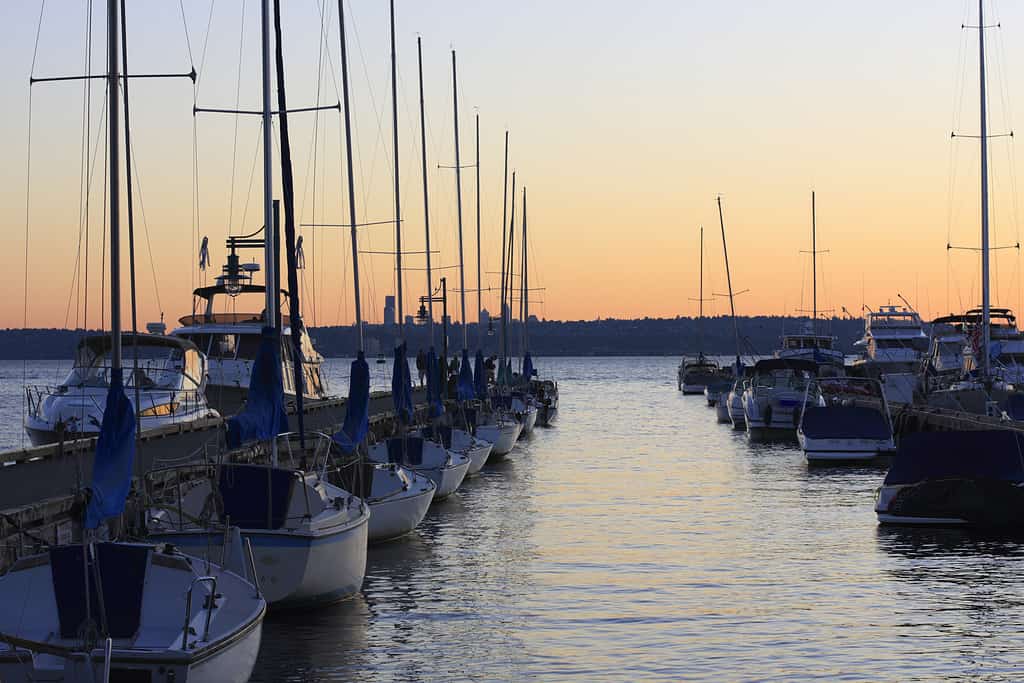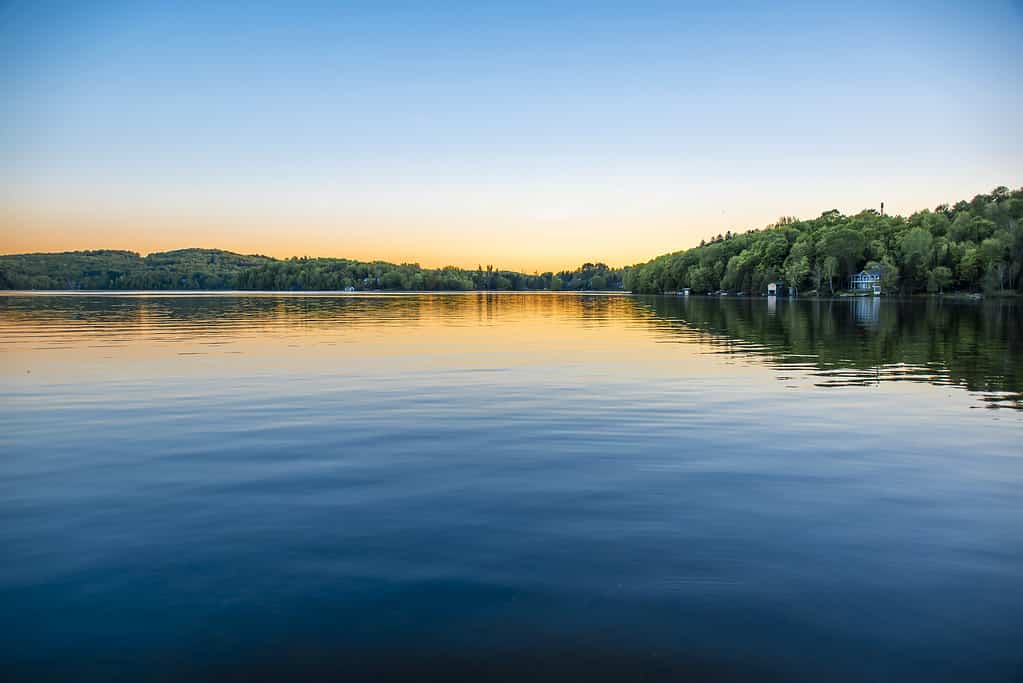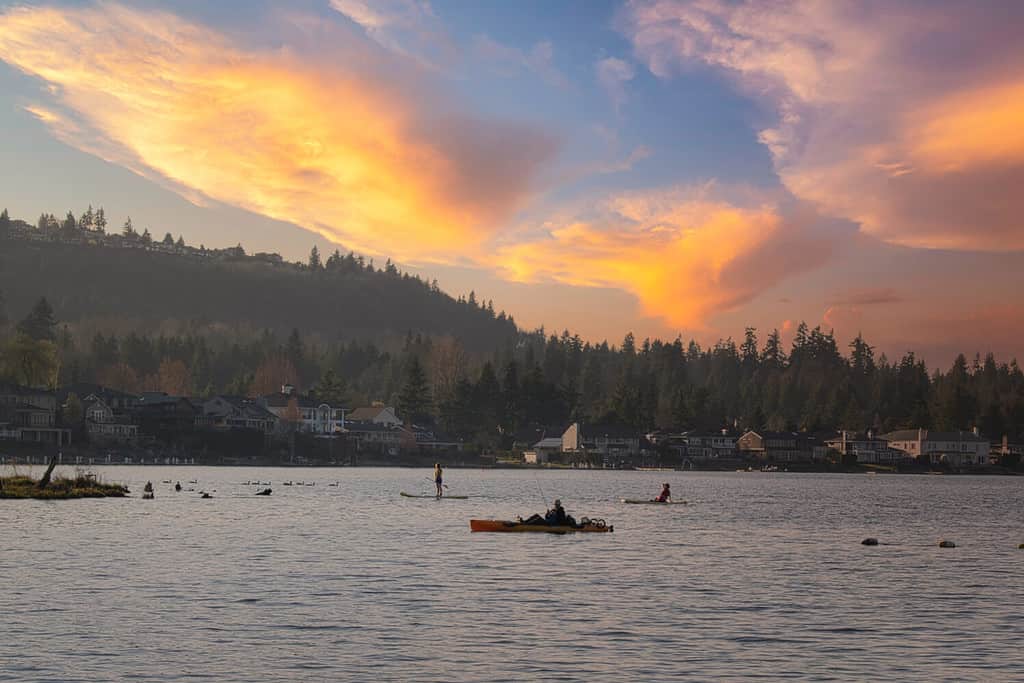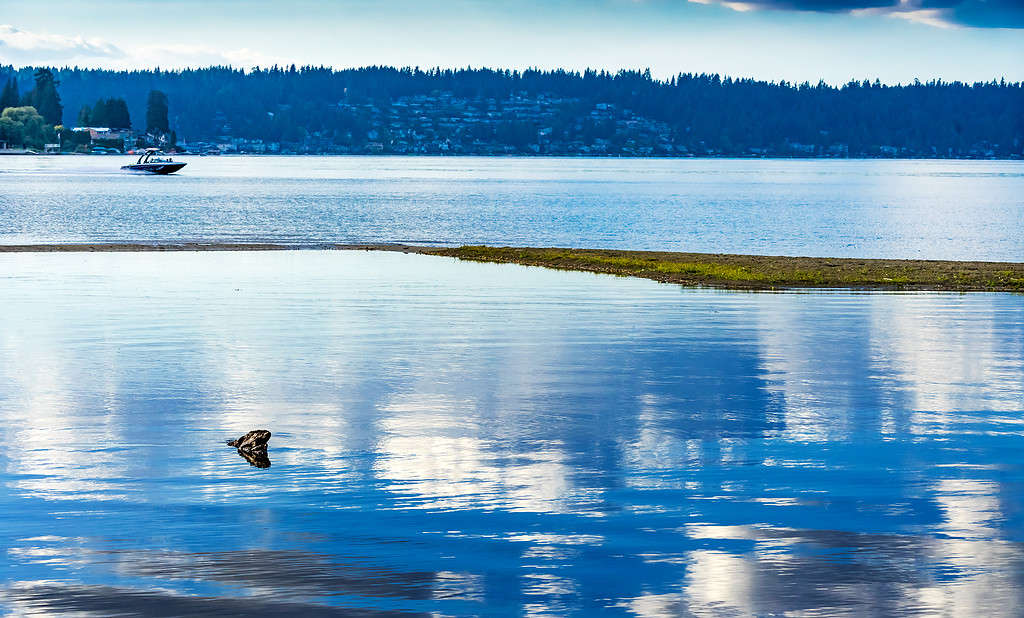Lake Sammamish has a rich history woven with resilience within the lands in which it resides in Washington State. Spanning over 7 miles in length and encompassing more than 8 square miles. This article will explore all that is Lake Sammamish, including its size, depth, history, recreational activities, and more.
Its shores and surrounding landscape are lined with a vibrant tapestry of biodiversity, sprawling with evergreen and mountainous vistas. Its waters play host to a diverse array of fish species as well. As the seasons change, Lake Sammamish serves as a hotspot for recreation, both on and off the water. Locals and visitors can enjoy boating, fishing, swimming, walking along the shores, and many other activities. In addition, due to its proximity to various cities and the major cities of Seattle and Bellevue, Lake Sammamish is surrounded by convenience across restaurants, lodging, and nature experiences. Offer not just respite but an opportunity to partake in the region’s unique ambiance.

In the grand expanse of Washington State, Lake Sammamish is a lake that serves as a popular recreational hub for both locals and visitors. It is close to the convenience of major cities and the seclusion of nature.
©© George Mavroudes/iStock via Getty Images
Location
Within the breathtaking expanse of Washington, Lake Sammamish graces the western landscape with its expansive size. This freshwater lake, stretching over 7 miles in length, lies roughly 8 miles to the east of Seattle. The cities of Issaquah, Sammamish, Redmond, and Bellevue surround the lake.

Lake Sammamish is located roughly 8 miles east of Seattle, residing in King County. A handful of cities surround the lake. They include the cities of Issaquah, Sammamish, Redmond, and Bellevue.
©SEASTOCK/iStock via Getty Images
History
Lake Sammamish is the second-largest lake in King County and the sixth-largest lake in Washington. It is a significant lake of recreation in the State of Washington due to its size and proximity to a variety of densely populated cities.
Indigenous Peoples
Before the arrival of European settlers, indigenous communities inhabited the shores of Lake Sammamish, notably the Duwamish people. The lake and its surroundings provided these communities with a bounty of resources, from abundant fish stocks to lush flora and fauna. The Duwamish and other local tribes honored the sacred nature of the land and the interconnectedness of all living things. The lake held spiritual significance. It was a source of sustenance, a place of gathering, and a canvas for their history.
European Settlement
Change swept through the region in the 19th century as European settlers began to explore and establish a presence in the Pacific Northwest. The Oregon Trail and other routes of westward expansion brought pioneers seeking new horizons. This period marked the beginning of a new chapter in the lake’s history, as the settlers displaced native tribes from the land and established their communities, forever altering the natural landscape. Farming overtook the land surrounding the lake, specifically the south end.
Modern Conservation
As the 20th century unfurled, the importance of preserving natural wonders became increasingly apparent. With its ecological diversity and stunning beauty, Lake Sammamish was a major resource for people. And, over time, it was in significant need of safeguarding. In the face of urbanization and development, much of the farmland around the lake was willed or sold to the state in the mid-1900s. On July 27, 1952, Sammamish State Park, hugging the southern end of Lake Sammamish, was established and opened to the public.
Today, Lake Sammamish is an example of urbanization and conservation working in tandem. It has experienced issues with pollution and flooding due to urbanization. However, conservation efforts have helped manage and mitigate human-made problems. It remains a reservoir of biodiversity, a wildlife sanctuary, and a retreat for those seeking solace in nature’s embrace close to city life. The history of Lake Sammamish is an ongoing narrative that underscores the intricate relationship between humanity and the environment.

Lake Sammamish is approximately 7.3 miles (11.7 kilometers) long, 1.5 miles (2.4 kilometers) wide, and has a surface area that consists of roughly 4,897 acres.
©Valerii Tereshchenko/iStock via Getty Images
Size
Lake Sammamish boasts considerable dimensions that influence awe and admiration. This natural wonder, with miles of shoreline, stretches a length of approximately 7.3 miles (11.7 kilometers) and a width that extends up to 1.5 miles (2.4 kilometers). The expansive surface area of this lake consists of roughly 4,897 acres, an expanse that mirrors the boundless beauty of the surrounding evergreen scenery.

Lake Sammamish boasts depths that range from 57 to 105 feet (18 to 32 meters). The water temperature fluctuates throughout the year. In the summer, temperatures of around 55 degrees Fahrenheit (12.8 degrees Celsius) are common. In contrast, in the winter, temperatures average 44 degrees Fahrenheit (6.7 degrees Celsius).
©iStock.com/John Twynam
Depth
The average depth of Lake Sammamish reaches approximately 58 feet (18 meters), which is home to a wide variety of aquatic life and geological features. As we explore even further into the watery depths of the lake, its maximum depth reaches around 105 feet (32 meters).

Lake Sammamish has been a recreational hub for many decades. This is due to its proximity to many cities, which include Seattle, Bellevue, Issaquah, the city of Sammamish, Redmond, and more. Popular activities include both water-based and land-based experiences, ranging from volleyball and tennis to rowing and kayaking.
©Michael J Magee/Shutterstock.com
Water level
Lake Sammamish experiences mild fluctuations in its water level, a natural ebb and flow that mirrors the delicate equilibrium of its ecosystem.
Throughout the year, the water level of Lake Sammamish undergoes a slight transformation. As the rains grace the landscape and the snowmelt trickles down from the surrounding mountains, the lake’s water level swells in response. It typically reaches its peak in the spring, when the lake reaches its highest levels, averaging around 28 to 29 feet, harmonizing with the landscape’s renewal.
Conversely, as the dry embrace of summer unfolds, the lake’s water level recedes. This gradual decline is a reflection of the seasonal rhythm, where the water retreats to levels of approximately 26 feet by autumn.
An intricate interplay of meteorological and hydrological factors guides the water level’s delicate fluctuation. The inflow of rain, snowmelt, and groundwater, combined with the lake’s outlet and natural evaporation, shape its fluctuations. Human activity and the management of water resources also influence it.
Records of the lake’s lowest and highest levels have been recorded in recent years, where historical observations and scientific records have chronicled moments of moderate water level changes. These instances often coincide with climatic anomalies or weather events that magnify the lake’s responsiveness to nature’s cues. The highest water level was recorded on February 9, 2020, measuring 31.17 feet. In contrast, the lowest level was recorded on September 15, 2021, measuring 25.56 feet.
Water Temperature
Furthermore, Lake Sammamish’s temperature echoes the seasons’ ebb and flow. In the warmer embrace of summer, the lake’s waters gently warm to a still chilly temperature, reaching around 55 degrees Fahrenheit (12.8 degrees Celsius). As the tendrils of winter’s chill extend their grasp, the lake’s temperature descends, reaching cooler temperatures of around 44 degrees Fahrenheit (6.7 degrees Celsius).
Wave Activity
As the wind dances upon the lake’s surface, Lake Sammamish’s waves, though not known for their towering heights, can still create a sense of motion and energy. These waves, influenced by weather conditions and the lake’s geography, often reach heights of up to 1 to 2 feet, lending a gentle, rhythmic cadence to the water’s surface.

Lake Sammamish is surrounded by multiple parks. They include Sammamish State Park on the southern end, Marymoor Park on the north end, and Idylwood Park on the northeast section. Sammamish State Park and Marymoor Park are the largest, both expanding over 500 acres each.
©bpperry/iStock via Getty Images
Geology
Lake Sammamish is a tranquil oasis carved by the hands of time and nature’s creative forces. Glaciers shaped their origins as giant ice sheets moved across the terrain during the last ice age, and a glacial depression formed. Lake Sammamish was created by a massive ice sheet that reached the Puget Sound. Sand and gravel were deposited into the lake from a river delta, accounting for sediment contents. It is thought that the depth of Lake Sammamish was 450 feet deeper than it is now. This is due to the lake being far higher than the delta deposits. Furthermore, Lake Sammamish is located on the Seattle Fault, which likely accounts for the undersea landslides that were discovered.
The timeline of the lake’s formation unfolds over thousands of years. The process began around 15,000 to 12,000 years ago during the waning stages of the last ice age. As these massive glaciers receded, the land they once dominated underwent a profound transformation. Over time, the glaciers created a depression. The ice also carved basins that filled with water. This resulted in the birth of many lakes.
This geological process holds a mosaic of sedimentary layers within its depths, a living testament to the many years of natural history that have unfolded since its creation. The surrounding landscape, adorned with lush foliage, rolling hills, and towering mountains across further horizons, is a canvas painted by the passage of time and the touch of the elements.

Lake Sammamish is surrounded by gorgeous, lush evergreen landscapes. It also has beautiful views of the nearby Mount Rainier and North Cascade Mountains.
©gmc3101/iStock via Getty Images
Fishing
Lake Sammamish is a haven for recreation. This unique lake, adorned with its sparkling waters and verdant surroundings, offers a rich tapestry of fishing opportunities, abundant species, and seasonal rhythms that paint a vivid portrait of nature’s bounty.
Common Fish Species
Within the depths of Lake Sammamish, you can find a diverse ensemble of fish species. Each contributes to the lake’s intricate ecology. Among the most common inhabitants are wild coastal cutthroat trout, smallmouth bass, and yellow perch. Bass enthusiasts find joy in pursuing both largemouth bass and smallmouth bass, each offering a distinct angling experience. Other species present include the brown bullhead, chinook salmon, coho salmon, pumpkinseed sunfish, signal crayfish, sockeye salmon, and threespine stickleback. Species that are present but are protected from being fished include kokanee, steelhead trout, and specific salmon species. Some species have declining populations. However, the overall community of fish species in Lake Sammamish showcases the rich diversity of life sustained within its depths.
Fishing Techniques and Seasons
Lake Sammamish invites anglers to explore an array of fishing techniques, from casting from the shore to trolling from boats. With its warming embrace, spring ushers in the start of trout fishing season as these vibrant fish venture closer to the surface. It offers conditions for bass fishing all year round, and the waters come alive with their energetic movements. Spring, summer, and fall provide short-lived salmon seasons, beckoning salmon enthusiasts to engage in the pursuit of specific salmon species. It is a captivating endeavor that rewards with both challenge and reward.
Rules and Regulations
It’s crucial to respect and adhere to the rules and regulations that safeguard the delicate balance of Lake Sammamish’s ecosystem. Anglers must obtain the necessary fishing licenses. Anglers must also consult local authorities for the most up-to-date information on fishing regulations, bag limits, and any seasonal closures that ensure the sustainability of the fish populations.
Conservation
Lake Sammamish’s vibrant fishing opportunities are intertwined with the conservation ethos guiding this aquatic sanctuary’s stewardship. Responsible fishing practices, including catch-and-release strategies, protect the local fish populations and allow future generations to share in the sport.

Kokanee populations in Lake Sammamish are dwindling and are said to consist of less than 100 individuals.
©StephenBridger/iStock via Getty Images
Boating and Other Activities
Lake Sammamish is a canvas of limitless possibilities. This enchanting lake offers a panorama of activities that cater to every whim and fancy. Whether your heart yearns for boating, swimming, or embracing the tranquil beauty of nature, Lake Sammamish offers plentiful opportunities for all interests and skill levels.
Parks and Trails
Lake Sammamish hosts Lake Sammamish State Park on the south end, a sanctuary that beckons nature lovers and adventurers alike. This sprawling parkland spans roughly 531 acres. It is a day-use park with about 6,858 feet of waterfront on Lake Sammamish. Here, visitors can indulge in a diverse array of activities. Some include hiking along nature trails to picnicking on shores kissed by gentle breezes or even hanging hammocks within the trees, perhaps accompanied by a good book. There are plentiful docks, boat launches, swimming areas, picnic tables, park grills, restrooms, and more.
Moreover, Marymoor Park borders the north end of the lake. It consists of approximately 640 acres and hosts a plethora of recreational activities. Some of these include various sports facilities, rock climbing, a 40-acre off-leash dog park, a velodrome, and a biking and walking trail. In addition to a radio control aircraft flying field, a pet memorial garden, a public garden, and the historic Willowmoor farm. It also has convenient boat launches, swimming areas, picnic tables, park grills, restrooms, and more.
Additionally, Idylwood Park is a 17-acre park. You can find it on the northwestern shores of Lake Sammamish. Though smaller in size, it features a swimming beach, a bathhouse, restrooms, picnic tables, and boat launches, to name a few aspects.
Finally, East Lake Sammamish Trail is an 11-mile recreational trail. It borders the east side of Lake Sammamish from Marymoor Park in Redmond to Gilman Boulevard in Issaquah.
Boating
As the sun’s rays caress the water’s surface, boaters enjoy the grand expanse of Lake Sammamish. This aquatic playground offers various boating experiences. From motorboats that cut through the waves with exhilaration to the serene tranquility of kayaking or canoeing. They allow you to savor every ripple and reflection with excitement. The lake’s gentle embrace accommodates both the thrill-seekers and those seeking solace in the rhythmic lull of the waters.
Swimming, Water Activities, and Other Activities
For those yearning to immerse themselves in the lake’s chill waters, you can enjoy swimming areas scattered around the lake. The lake’s waters offer a refreshing haven during hot summer days, a canvas where laughter and splashes merge. Water enthusiasts can also revel in paddleboarding, which offers a slower glide atop the water’s surface. It also allows one to connect intimately and openly with the elements. Other popular activities on Lake Sammamish include sailing, rowing, jetskiing, waterskiing, wakeboarding, and tubing. Meanwhile, on the land surrounding Lake Sammamish, baseball, softball, volleyball, soccer, basketball, tennis, wildlife viewing, bird watching, walking, and cycling are all popular activities to enjoy while the ambiance of the lake.
As for the seasons’ influence on activities on and around Lake Sammamish, the lake is not solely confined to the warmer months. Opportunities to enjoy Lake Sammamish can be enjoyed year-round. The lake’s allure persists as winter paints the landscape with its frosty touch. All activities that don’t involve getting wet and diving into the lake’s waters persist. Boating takes on a different dimension as the waters mirror the serene tranquility of the surrounding hills, and the winter chill invites contemplation amidst nature’s majesty. Though foot traffic around the lake may be less in the colder months, there is still plenty to enjoy as long as you wear the proper clothing!
Camping
The Hans Jensen youth group camping area is located within Lake Sammamish State Park. It can accommodate a maximum of roughly 200 people and up to 40 cars. Within the site are more than 30 picnic tables, a covered picnic shelter, 12 stoves, and 3 toilets.
Although there is no camping along Lake Sammamish, nearby campgrounds within short driving distances extend their welcome. Exploring the beauty of nearby lakes and parks during the day and retiring to a cozy campsite.
Resorts, Restaurants, and Nearby Towns
Lake Sammamish’s charm extends beyond its shores, with various quaint towns, inviting eateries, and even a small lakeside resort. Nestled against the backdrop of the lake’s beauty, these establishments offer respite, recreation, and culinary delights. Here, you can savor gourmet meals while gazing upon the tranquil waters. Or unwind in the embrace of the private lakeside resort Vasa Park Resorts, which, for a small fee, offers comfort and convenience to enjoy parkside delights.

Rowing, sailing, kayaking, canoeing, and paddleboarding are all popular water activities to enjoy on Lake Sammamish.
©petesaloutos/iStock via Getty Images
Where is Lake Sammamish Lake Located on a Map?
Lake Sammamish is located in the state of Washington in the United States. It lies to the east of Seattle by approximately 8 miles. Remond borders its northern shore, and the city of Sammamish borders its eastern shore. Moreover, Issaquah borders its southern shore, and Bellevue borders its western shore, respectively. The lake is situated in King County and is part of the Puget Sound region.
The photo featured at the top of this post is © © George Mavroudes/iStock via Getty Images
Thank you for reading! Have some feedback for us? Contact the AZ Animals editorial team.







